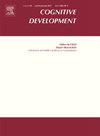机械空间支持语言的发展:从3- 6岁儿童的解释看
IF 1.8
3区 心理学
Q3 PSYCHOLOGY, DEVELOPMENTAL
引用次数: 0
摘要
目前的研究测试了3到6岁的儿童如何用语言编码机械支持事件的因果机制(例如,一个人将一个物体粘在另一个物体上)。首先向孩子们介绍两个物体,并熟悉它们的启示(例如,物体是否粘在盒子上),然后问他们“为什么会这样?”在两个测试阶段,孩子们同时观看了一对描述一致或不一致支持的事件(例如,物体在先前粘附时落下,或者在先前掉落时粘附)。孩子们再次被问到:“为什么会这样?”3- 6岁儿童对因果解释的使用(例如,“玩具粘在盒子上是因为有胶水”)增加,并且儿童使用的因果解释类型随着年龄的增长而变化。这些发现揭示了儿童机械支持语言习得的发展滞后,表明儿童因果表征的概念变化可能影响他们的机械支持语言习得。本文章由计算机程序翻译,如有差异,请以英文原文为准。
Development of mechanical spatial language of support: Insight from 3- to 6-year-old children’s explanations
The current study tested how 3- to 6-year-old children encode causal mechanisms in language for Mechanical Support events (e.g. a person adheres one to another object). Children were first introduced to two objects and were familiarized with their affordances (e.g., whether the objects adhered to a box or not), then asked “Why did that happen?” During two test phases, children then simultaneously viewed a pair of events that depicted consistent or inconsistent support (e.g., the object fell when it previously adhered or it adhered when it previously fell). Children were again asked, “Why did that happen?” Children’s use of causal explanations (e.g., "The toy is sticking to the box because there is glue") increased from 3- to 6-years of age, and the types of causal explanations that children used changed with age. These findings shed light on the developmental lag that has been reported in children’s acquisition of Mechanical Support Language, suggesting that conceptual changes in children’s causal representations may influence their Mechanical Support language acquisition.
求助全文
通过发布文献求助,成功后即可免费获取论文全文。
去求助
来源期刊

Cognitive Development
Multiple-
CiteScore
3.20
自引率
5.60%
发文量
114
期刊介绍:
Cognitive Development contains the very best empirical and theoretical work on the development of perception, memory, language, concepts, thinking, problem solving, metacognition, and social cognition. Criteria for acceptance of articles will be: significance of the work to issues of current interest, substance of the argument, and clarity of expression. For purposes of publication in Cognitive Development, moral and social development will be considered part of cognitive development when they are related to the development of knowledge or thought processes.
 求助内容:
求助内容: 应助结果提醒方式:
应助结果提醒方式:


